 |
PYE P123BQ/R-L U.K. - 1958 |
 |
 Description
Description |
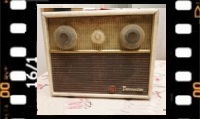 |
Descrizione Restauro e Schema elettrico |
|||
|
|
|||||
 |
 |
 |
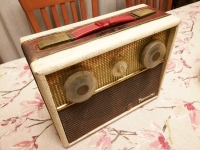 |
||
 |
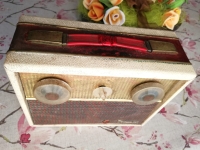 |
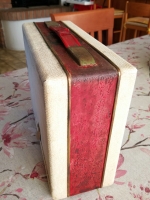 |
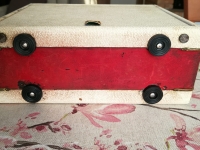 |
||
 La radio portatile a transistor Pye P123BQ fu
commercializzata nel regno Unito a partire dal 1957. A metà degli anni '50 i transistor erano
un'assoluta novità e il mercato delle apparecchiature che li
utilizzavano era un'avventura piena di
incognite. C'era la reale possibilità che qualcosa potesse andare storto
e che la novità dei transistor facesse fiasco. Aziende elettroniche
floride come la Pye inglese furono comprensibilmente caute
nell'intraprendere quella nuova strada.
La radio portatile a transistor Pye P123BQ fu
commercializzata nel regno Unito a partire dal 1957. A metà degli anni '50 i transistor erano
un'assoluta novità e il mercato delle apparecchiature che li
utilizzavano era un'avventura piena di
incognite. C'era la reale possibilità che qualcosa potesse andare storto
e che la novità dei transistor facesse fiasco. Aziende elettroniche
floride come la Pye inglese furono comprensibilmente caute
nell'intraprendere quella nuova strada.Fu per tale motivo che la prima radio a transistor in Inghilterra nel 1956 non fu venduta col il marchio Pye, ma come fecero altre ditte elettroniche dell'epoca la Pye utilizzò un altro marchio, quello della PAM (Pamphonic Reproducers Ltd.), una delle sue società sussidiarie. Le parti elettroniche della radio erano progettate, prodotte e assemblate interamente nello stabilimento Pye di Newmarket, il mobiletto invece era un progetto della PAM. Il prezzo di vendita per il PAM 710 fu di £ 32, circa il doppio di quello di una radio portatile a valvole dell'epoca. La PAM comunque ebbe successo nelle vendite e nel gennaio 1957 la Pye decise di sostituire il PAM 710 con un proprio modello di marca Pye: la P123-BQ. Il nuovo apparecchio aveva un aspetto simile al 710, un circuito elettrico migliorato che utilizzava 6 transistor invece di 8 e soprattutto fu venduto a un prezzo molto più conveniente: 17 Sterline, 13scellini e 4pence. Questo nuovo modello ebbe un grande successo di mercato tanto che da quel periodo in Gran Bretagna non si costruirono più radio portatili con gli ormai obsoleti tubi elettronici. Il modello qui descritto è una P123BQ/R-L con inciso il numero 840277 sullo chassis e 041195 sul circuito stampato. La radio fu probabilmente costruita a fine 1958 o all'inizio del 1959 perché al posto della serie V6 di transistor della NKT (Newmarket Transistors Ltd.) da tale anno la P123BQ/R aveva iniziato a utilizzare l'allora nuovissima serie OC della Mullard: OC44, OC45, OC45, OC78D, OC78, OC78. La "L" nella sigla indica che oltre alle Onde Medie la radio riceve anche l'intera gamma delle Onde Lunghe, e non solo una stazione preimpostata sui 1500 metri come nei modelli precedenti. Il circuito è una supereterodina a sei transistor, con uno stadio a Radio Frequenza, due stadi a Frequenza Intermedia che risuonano a 470 KHz e due stadi a Bassa Frequenza, con un push-pull di OC78 che pilota direttamente un altoparlante ellittico (17 x 4 cm) ad alta impedenza con l'avvolgimento a presa centrale (60 + 60 Ohm) per un totale di 120 Ohm. Le dimensioni dell'apparecchio sono: 24 x 20 x 10 cm e il peso senza batterie è di 2,4 Kg. Per merito delle dimensioni dell'altoparlante e del mobiletto in legno ricoperto da finta pelle la resa acustica è buona. Per l'alimentazione la radio impiega quattro economiche batterie da 1,5 V tipo C (R14) per un totale di 6 V. La radio era stata progettata per essere utilizzata anche a bordo di un veicolo perché su un è predisposta una presa d'antenna tipo autoradio e di un'uscita audio su connettore RCA. © IK3HIA 2023. |
|||||
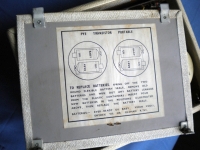 |
 |
 |
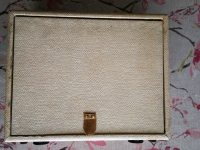 |
||
 The Pye P123BQ portable transistor radio was marketed in the UK since 1957.
In the mid-1950s, transistors were a completely new thing, and the
market for equipment that used them was a wild ride. There was a real possibility that something could go wrong and that the
novelty of transistors would fizzle out. Thriving electronics companies
like England's Pye were understandably cautious about taking this new
path.
The Pye P123BQ portable transistor radio was marketed in the UK since 1957.
In the mid-1950s, transistors were a completely new thing, and the
market for equipment that used them was a wild ride. There was a real possibility that something could go wrong and that the
novelty of transistors would fizzle out. Thriving electronics companies
like England's Pye were understandably cautious about taking this new
path.It was for this reason that the first transistor radio in England in 1956 was not sold under the Pye brand name but, as did other electronic companies of the time, Pye used that of PAM (Pamphonic Reproducers Ltd.), one of its subsidiary. The electronic parts of the radio were manufactured and assembled entirely in the Pye factory in Newmarket, the cabinet however was a PAM design. The retail price for the PAM 710 was £32, about double that of a portable tube radio of the time. The PAM was nevertheless a sales success and in January 1957 Pye decided to replace the PAM 710 with its own Pye brand model: the P123-BQ. The new device had a similar appearance to the 710, an improved electrical circuit that used 6 transistors instead of 8 and above all it was sold at a much more convenient price: 17 pounds, 13 shillings and 4 pence. This new model was such a great market success that from that period onwards portable radios with the now obsolete electronic tubes were no longer built in Great Britain. The model described here is a P123BQ/R-L with the serial number 840277 engraved on the chassis and the 041195 on the printed circuit. The radio was probably built at the end of 1958 or early 1959 because instead of the NKT V6 series transistors (Newmarket Transistors Ltd.) from that year the P123BQ/R had started to use the new OC Mullard series: OC44, OC45, OC45 , OC78D, OC78, OC78. The "L" in the abbreviation indicates that in addition to the Medium Waves the radio also receives the entire Long Wave range, and not just a preset station on 1500 meters as in previous models. The circuit is a six transistor superheterodyne, with a Radio Frequency stage, two Intermediate Frequency stages resonating at 470 KHz and two Audio Frequency stages, with an OC78 push-pull directly driving an elliptical loudspeaker (17 x 4 cm) high impedance with center tapped winding (60 + 60 Ohms) for a total of 120 Ohms. The dimensions of the device are: 24 x 20 x 10 cm and the weight without batteries is 2.4 kg. Thanks to the size of the loudspeaker and the wooden cabinet covered with imitation leather, the acoustic performance is good. The radio uses four inexpensive 1.5 V type C (R14) batteries for power supply for a total of 6 V. The radio was also designed for use in a vehicle because it has a socket on one side. radio-type antenna and an audio output on RCA connector. © IK3HIA 2023. |
|||||
|
|
|||||
|
Return to top of page
|
|||||
|
|
Return to: IK3HIA home page |
|
Return to: Transistor Radio |
|
Go to: Transistor diagrams |